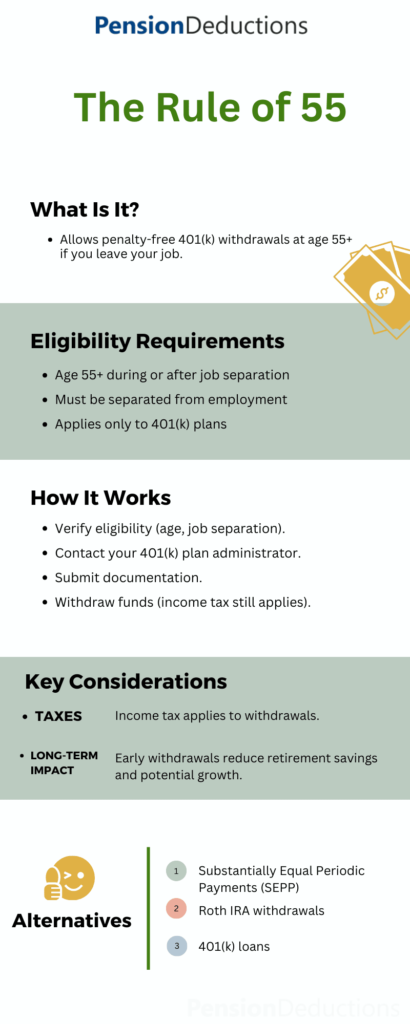The Rule of 55
What is the Rule of 55?
Understanding the Basics
Key Considerations
Who Can Benefit from the Rule of 55?
Eligibility Criteria
Age Requirement
You must be at least 55 years old in the year you separate from your employer.
Separation from Service
You must have left your job (whether voluntarily or involuntarily) during or after the year you turn 55.
401(k) Plan
The funds must come from a 401(k) plan sponsored by your employer.
Schedule a Free Consultation Now!
Scenarios where the Rule is helpful
Unexpected Job Loss
If you lose your job unexpectedly, you can access your retirement funds to cover living expenses.
Starting a Business
If you decide to venture into entrepreneurship, you can withdraw funds to invest in your business without facing penalties.
Health Issues
For individuals dealing with health issues, accessing retirement savings can provide financial relief.
How the Rule of 55 works?
Withdrawal Process
Verify Eligibility
Ensure you meet the age and employment separation criteria.
Contact Your Plan Administrator
Reach out to your 401(k) plan administrator to discuss your options for withdrawal.
Submit Necessary Documentation
You may need to provide documentation showing your age and separation from employment.
Withdraw Funds
Once approved, you can withdraw the funds you need.
Tax Implications
Limits on Withdrawals

Planning for Retirement with the Rule of 55
Strategic Considerations
Evaluate Your Financial Needs
Assess how much money you need and how it fits into your overall retirement strategy.
Consider Other Income Sources
Explore other income sources, such as part-time work or passive income, to minimize withdrawals.
Plan for Taxes
Understand the tax implications of your withdrawals and plan accordingly.
Long-Term Impact
Reduced Retirement Savings
Early withdrawals can significantly impact your retirement nest egg.
Future Financial Needs
Be mindful of your future financial needs and how early withdrawals may affect your retirement lifestyle.
Alternatives to the Rule of 55
Other Withdrawal Options
Substantially Equal Periodic Payments (SEPP)
This IRS rule allows individuals to take early withdrawals without penalties, but you must follow specific guidelines.
Roth IRA Withdrawals
Contributions to a Roth IRA can be withdrawn tax-free and penalty-free at any time, though earnings are subject to different rules.
Loans from Your 401(k)
Some plans allow participants to borrow against their 401(k) balance, providing a way to access funds without penalties.
Consulting a Financial Advisor
Schedule a Free Consultation Now!
Conclusion
While it allows penalty-free access to funds, careful planning and consideration of long-term impacts are crucial. Whether you’re navigating unexpected expenses or seeking to invest in a new venture, The Rule of 55 can be a helpful tool in your financial toolkit.
SHARE THIS POST
Explore the IRS Contribution Limits 2025 and learn how inflation adjustments can maximize retirement savings for individuals and employers alike.
Discover the new 401k limits in 2025, maximize your retirement savings, and secure a financially stable future.
Automatic portability of 401k plans in 2025 ensures seamless retirement savings transfers, preserving funds and enhancing financial security across careers.
Uncover how Social Security Reforms 2024 will impact retirees with crucial changes to taxes, benefits, and retirement age adjustments.


